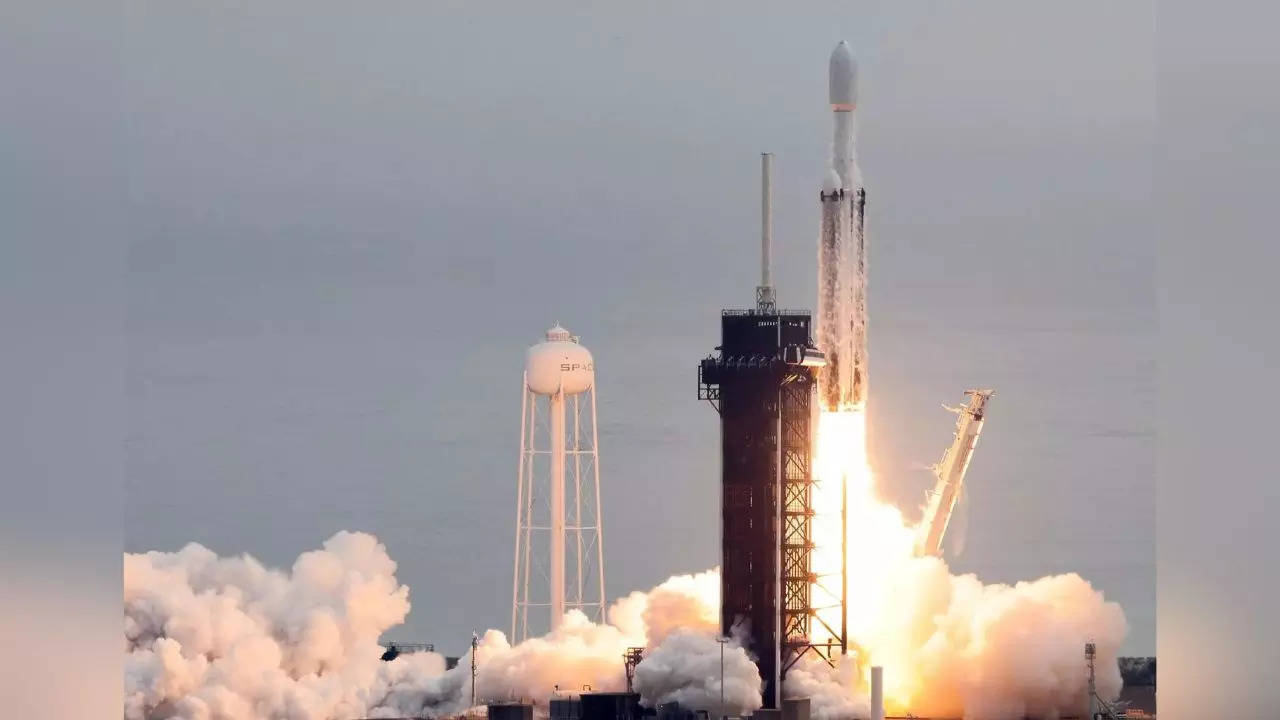NEW DELHI: US space agency Nasa on Friday launched a spacecraft to Psyche, a distant metal-rich asteroid that is the solar system‘s largest-known metallic object and is thought to be the remnant core of an ancient protoplanet.
The Psyche probe, folded inside the cargo bay of a SpaceX Falcon Heavy rocket, was slated for blastoff at 10:19 a.m. EDT (1419 GMT) from NASA’s Kennedy Space Center in Cape Canaveral on a planned journey 2.2 billion miles (3.5 billion km) through space.
Powered by a new kind of spaceship engine that uses solar-electric ion thrusters, a spacecraft, similar in size to a small van, is set to arrive at its destination in the outer region of the asteroid belt between Mars and Jupiter in nearly six years.
Its mission is to orbit around Psyche, a colossal asteroid measuring about 279 kilometres (173 miles) at its widest point, for 26 months. During this time, the spacecraft will use special instruments to study the asteroid’s gravity, magnetic properties, and composition.
Scientists believe that Psyche may have once been the molten core of a young planet, which eventually froze and broke apart due to collisions with other space objects during the early days of our solar system. Psyche orbits the sun at a distance about three times farther from Earth, even at its closest approach to our planet.
Psyche is about to be the first asteroid of its kind examined up close by a spacecraft. It’s thought to be made mostly of valuable metals like iron, nickel, and gold, with a total estimated value of 10 quadrillion dollars.
However, scientists want to clarify that the Psyche mission is not about mining in space. Its main goal is to learn more about how Earth and other rocky planets formed around cores of molten metal.
Earth’s hidden molten centre is too deep and too hot to ever be examined directly.
“So we say, tongue-in-cheek, that we’re going to outer space to explore inner space,” Lindy Elkins-Tanton, Psyche’s principal investigator for NASA’s mission partner Arizona State University, was quoted as saying by Reuters.
Psyche, discovered in 1852 and named for the goddess of the soul in Greek mythology, is the largest of only about nine known asteroids that appear from ground-based radar observations to consist largely of metal, with rocky material mixed in. Still, scientists can only guess at what it looks like, Elkins-Tanton told Reuters.
The Psyche orbiter will be released from the SpaceX rocket’s cargo bay about five minutes after launch, and take two hours to unfurl its twin solar arrays and point its communications antennae toward Earth, if all goes as planned.
The Psyche probe, folded inside the cargo bay of a SpaceX Falcon Heavy rocket, was slated for blastoff at 10:19 a.m. EDT (1419 GMT) from NASA’s Kennedy Space Center in Cape Canaveral on a planned journey 2.2 billion miles (3.5 billion km) through space.
Powered by a new kind of spaceship engine that uses solar-electric ion thrusters, a spacecraft, similar in size to a small van, is set to arrive at its destination in the outer region of the asteroid belt between Mars and Jupiter in nearly six years.
Its mission is to orbit around Psyche, a colossal asteroid measuring about 279 kilometres (173 miles) at its widest point, for 26 months. During this time, the spacecraft will use special instruments to study the asteroid’s gravity, magnetic properties, and composition.
Scientists believe that Psyche may have once been the molten core of a young planet, which eventually froze and broke apart due to collisions with other space objects during the early days of our solar system. Psyche orbits the sun at a distance about three times farther from Earth, even at its closest approach to our planet.
Psyche is about to be the first asteroid of its kind examined up close by a spacecraft. It’s thought to be made mostly of valuable metals like iron, nickel, and gold, with a total estimated value of 10 quadrillion dollars.
However, scientists want to clarify that the Psyche mission is not about mining in space. Its main goal is to learn more about how Earth and other rocky planets formed around cores of molten metal.
Earth’s hidden molten centre is too deep and too hot to ever be examined directly.
“So we say, tongue-in-cheek, that we’re going to outer space to explore inner space,” Lindy Elkins-Tanton, Psyche’s principal investigator for NASA’s mission partner Arizona State University, was quoted as saying by Reuters.
Psyche, discovered in 1852 and named for the goddess of the soul in Greek mythology, is the largest of only about nine known asteroids that appear from ground-based radar observations to consist largely of metal, with rocky material mixed in. Still, scientists can only guess at what it looks like, Elkins-Tanton told Reuters.
The Psyche orbiter will be released from the SpaceX rocket’s cargo bay about five minutes after launch, and take two hours to unfurl its twin solar arrays and point its communications antennae toward Earth, if all goes as planned.
Denial of responsibility! Swift Telecast is an automatic aggregator of the all world’s media. In each content, the hyperlink to the primary source is specified. All trademarks belong to their rightful owners, all materials to their authors. If you are the owner of the content and do not want us to publish your materials, please contact us by email – swifttelecast.com. The content will be deleted within 24 hours.


